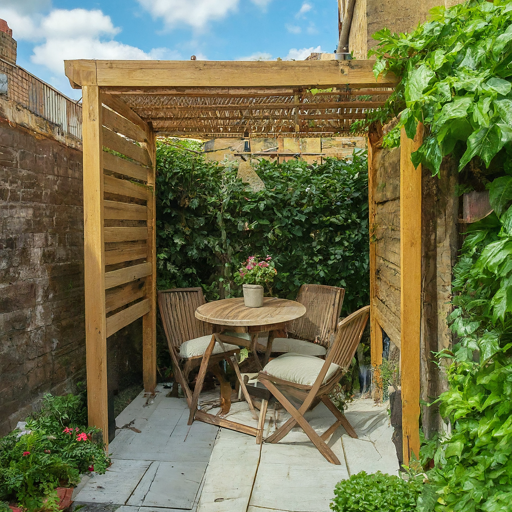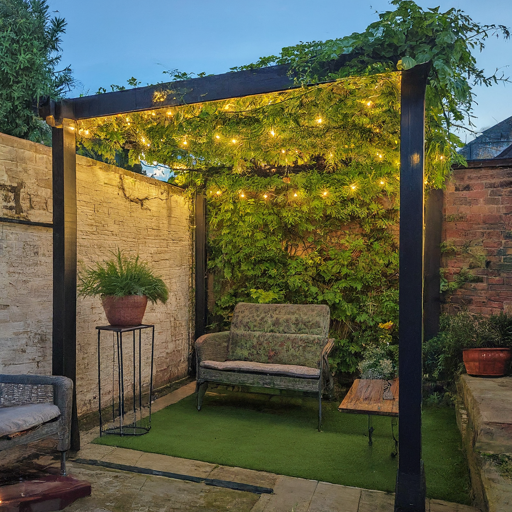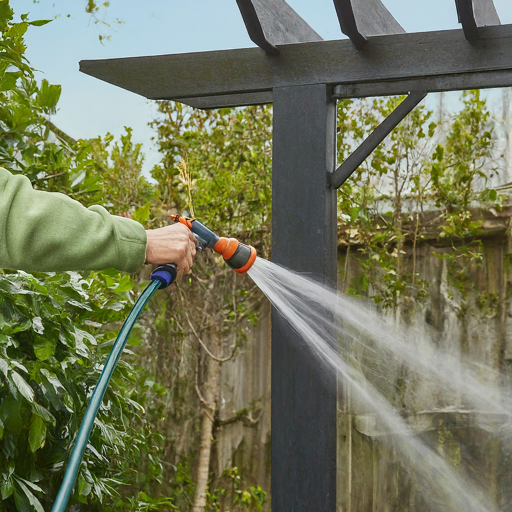Introduction
Creating a beautiful and functional outdoor space can be challenging when you have a small garden. However, incorporating a pergola can transform even the tiniest of gardens into a cozy sanctuary. Pergolas add vertical interest, provide shade, and create defined areas within your garden. This article explores how to design and install a pergola in a small garden, with image suggestions to inspire your project.
Benefits of Pergolas in Small Gardens
1. Maximizing Space: Pergolas help maximize limited space by creating a vertical focal point. They draw the eye upward, making the garden appear larger and more structured.
2. Defining Areas: A pergola can define different areas within a small garden. Whether it’s a seating nook, dining space, or a place for relaxation, a pergola helps create distinct zones.
3. Adding Shade and Comfort: Pergolas provide shade, making small outdoor spaces more comfortable during hot days. They can also support climbing plants, adding greenery and natural beauty.
Choosing the Right Pergola for a Small Space
1. Size and Scale: Choose a pergola that fits the scale of your garden. A large pergola can overwhelm a small space, so opt for a compact design. Measure your garden carefully and select a pergola that leaves enough room for movement and other garden features.
2. Material: Select materials that complement your garden’s style and are easy to maintain.
- Wood: Wooden pergolas offer a natural and classic look. Cedar and pressure-treated pine are popular choices for their durability and resistance to rot.
- Metal: Metal pergolas, such as those made from aluminum or steel, provide a sleek and modern appearance. They are low-maintenance and highly durable.
- Vinyl: Vinyl pergolas are a low-maintenance option that resists fading, peeling, and cracking. They offer a clean and contemporary look.
3. Design: Consider the design elements that will enhance your small garden.
- Open Roof: An open-roof pergola allows more light to filter through, making the space feel larger. It also provides a framework for climbing plants.
- Corner Pergola: Corner pergolas make efficient use of space by fitting snugly into a garden corner, creating a cozy nook.
- Retractable Canopy: A pergola with a retractable canopy offers flexible shade options, allowing you to control the amount of sunlight.
Planning and Preparation
1. Assess the Space: Evaluate your garden to determine the best location for the pergola. Consider factors such as sun exposure, existing plants, and the layout of your garden. Choose a spot that maximizes the pergola’s benefits and complements the overall design.
2. Gather Tools and Materials: Ensure you have all the necessary tools and materials for the project. Common tools include a tape measure, level, power drill, hammer, and ladder. Gather the pergola kit or individual components, along with any additional materials for securing the structure.
3. Prepare the Ground: Clear and level the area where the pergola will be installed. Remove any debris, rocks, or vegetation. Mark the locations for the posts according to your pergola’s design and size.
Building and Installing the Pergola

1. Assemble the Frame: Begin by assembling the main frame of the pergola. Follow the manufacturer’s instructions if using a kit, or use your own plans if building from scratch.
- Install Posts: Secure the posts in place. For a permanent installation, consider setting the posts in concrete. If installing on a patio, use post anchors or brackets.
- Attach Beams: Attach the horizontal beams to the posts, ensuring they are level and secure.
- Add Rafters: Place the rafters across the beams, spacing them evenly. Secure each rafter with screws or brackets.
2. Add Finishing Touches: Complete the pergola with any additional elements, such as a canopy, curtains, or decorative brackets.
- Canopy: Install a retractable or fixed canopy for shade. Choose a material that is weather-resistant and complements your garden’s style.
- Curtains: Outdoor curtains provide privacy and additional shade. Select fabrics that are durable and easy to clean.
- Decorative Elements: Add decorative brackets, finials, or other details to enhance the pergola’s appearance.
Personalizing Your Pergola

1. Greenery and Plants: Incorporate plants to add natural beauty and create a lush atmosphere.
- Climbing Plants: Choose climbing plants such as wisteria, jasmine, or clematis to grow on your pergola. These plants provide shade and enhance the pergola’s visual appeal.
- Potted Plants: Arrange potted plants around the pergola to add color and texture. Use a variety of sizes and types to create interest.
2. Lighting: Add lighting to make your pergola usable and inviting in the evening.
- String Lights: String lights create a warm, cozy ambiance. Drape them across the beams or wrap them around posts.
- Lanterns: Hanging lanterns add charm and provide functional lighting. Choose solar-powered options for an eco-friendly solution.
- Fairy Lights: Fairy lights offer a magical touch. Weave them through climbing plants or hang them from the pergola’s roof.
3. Furniture and Decor: Select furniture and decor that complement the size and style of your pergola.
- Seating: Choose compact, comfortable seating such as a small sofa, chairs, or a bench. Add cushions and throws for extra comfort.
- Table: A small table provides a convenient surface for dining, drinks, or decor. Opt for a foldable or bistro-style table to save space.
- Decorative Accents: Personalize the space with outdoor rugs, throw pillows, and decorative items that reflect your style.
Maintenance Tips

1. Regular Cleaning: Keep your pergola looking its best with regular cleaning. Use a garden hose or mild soap and water to remove dirt and debris. Avoid abrasive cleaners that could damage the finish.
2. Inspect and Tighten: Periodically inspect your pergola for any signs of wear or damage. Tighten any loose bolts or screws and replace any damaged components to ensure the structure remains secure.
3. Protect the Finish: For wooden pergolas, apply a fresh coat of paint or stain every few years to protect against moisture and UV damage. Metal pergolas may require occasional touch-ups to prevent rust and corrosion.
Conclusion
A pergola can transform a small garden into a charming and functional sanctuary. By carefully selecting the right pergola, preparing the space, and adding personal touches, you can create an outdoor area that is both beautiful and practical. Whether you use your pergola for relaxation, dining, or gardening, it will enhance your small garden and provide a delightful space to enjoy.
Leave a Reply